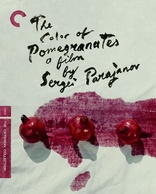The Color of Pomegranates Blu-ray Movie
HomeThe Color of Pomegranates Blu-ray Movie 
Նռան գույնը / Sayat NovaCriterion | 1969 | 80 min | Not rated | Apr 17, 2018
Movie rating
7.4 | / 10 |
Blu-ray rating
| Users | 0.0 | |
| Reviewer | 4.0 | |
| Overall | 4.0 |
Overview
The Color of Pomegranates (1969)
A highly unconventional biopic of the 18th-century Armenian poet Sayat-Nova recounted in a succession of opulently exotic tableaux.
Starring: Sofiko Chiaureli, Melkon Alekyan, Vilen Galstyan, Gogi Gegechkori, Spartak BagashviliDirector: Sergei Parajanov
| Foreign | Uncertain |
| Drama | Uncertain |
| Music | Uncertain |
| Biography | Uncertain |
| History | Uncertain |
Specifications
Video
Video codec: MPEG-4 AVC
Video resolution: 1080p
Aspect ratio: 1.37:1
Original aspect ratio: 1.37:1
Audio
Armenian: LPCM Mono
Subtitles
English
Discs
Blu-ray Disc
Single disc (1 BD)
Playback
Region A (locked)
Review
Rating summary
| Movie | 4.0 | |
| Video | 4.0 | |
| Audio | 5.0 | |
| Extras | 4.5 | |
| Overall | 4.0 |
The Color of Pomegranates Blu-ray Movie Review
Reviewed by Dr. Svet Atanasov February 10, 2019Sergei Parajanov's "The Color of Pomegranates" (1969) arrives on Blu-ray courtesy of Criterion. The supplemental features on the disc include an exclusive new audio commentary by critic Tony Rayns; Patrick Cazals' documentary "Sergei Parajanov: The Rebel"; new video essay by film scholar James Steffen; and more. The release also arrives with an illustrated leaflet featuring critic Ian Christie's essay "Parajanov Unbound" and technical credits. In Armenian, with optional English subtitles for the main feature. Region-A "locked".
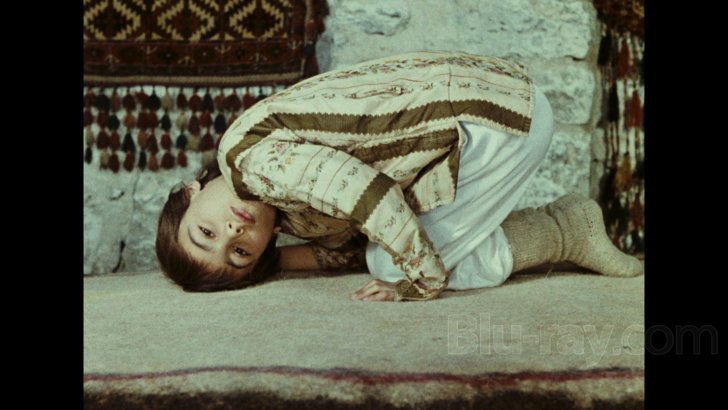
So, you are twenty minutes into Sergei Parajanov’s film and you feel completely lost. You see the actors moving, you recognize that forms and colors are used in very particular ways, and you read the texts that are supposed to place everything in a proper context. But you have trouble comprehending the story. In fact, you are beginning to wonder if there is one. Your mind is also entertaining the idea that there might be a special clue that you need to locate so that the film begins to make sense to you. Could it be that you missed it?
You decide to be patient and hope that eventually it will all come together and you will be able to agree with the folks that have praised Parajanov’s film over the years. After all, you have been down this road before with a couple of Federico Fellini and Alejandro Jodorowsky’s films. You also recall that it took quite a bit of time to figure out those really strange Lech Majewski and Dusan Makavejev films that you saw decades ago. It will happen again, you will get it, you just have to be patient and focus on the visuals because with these types of films there is always a visual clue that eventually unlocks their mystery. Always. You just need to spot it.
But the more time passes by, the more relentless the stylization becomes, and you begin to sense that your frustration is about to collapse your patience. It has been over an hour now and you have not been able to identify the crucial clue. You have witnessed character transformations and strange relationships and noted a passage of time that still do not make perfect sense to you. Why? What are you missing?
When the final credits roll, you feel defeated. There is a part of you that does not want to admit it, but deep inside you know the truth -- you just could not put all of the scattered pieces of what you had read is a fascinating film in the proper order. You wanted but could not experience the same magical film that you were prepared to see. Another part of you then begins insisting that you need to give the film a second chance while being a lot more careful with its heavy symbolism. That’s it. You should have done a better job staying focused. You are slightly annoyed with yourself now, but you will see the film again and try to do better. It can’t be that difficult, can it?
Actually, it can, and it is, and you should ignore anyone insisting otherwise. If you do so, you will save yourself from a great deal of frustration.
Parajanov’s film is a big puzzle and there isn’t a single clue that can solve it in a way that would make perfect sense to you. All of the critics that have argued the exact opposite have done so without being honest about their experience with the film because the symbolism in it is endless, and because there are unique themes in it that are intertwined in ways that conventional criticism quite simply isn’t capable of rationalizing. In fact, this is arguably the key reason why the film is worth seeing -- it alters the way in which a story is told via the medium and does so in such a drastic fashion that its structural relevance becomes just a useful nuance.
Of course, the fact that the Soviet censors played with and, for the most part, imposed their will on this film makes everything that takes place in it that much more complicated. It is irrelevant that there are different cuts of the film because at the end of the day it is unclear how many compromises Parajanov made to present an acceptable version of his vision to another party that did not get it to begin with. Regardless of what has been said and written in the past, it is not even clear that Parajanov actually had everything in the proper order when he shot the film. Quite predictably, everyone that has done some type of deconstructive work while attempting to explain the film has done so while operating with a wide range of guesses.
At the core of the film is an unorthodox attempt to retell the story of the great Armenian poet Sayat-Nova, but the different phases of his life are presented as cinematic canvases that are simply used to dazzle with a very particular type of stylization. It is an experiment that could work if you can tolerate it and, in the process, convince yourself that you get everything that Parajanov wanted to express through the stylization, but it can also be an unbearable and ultimately incredibly frustrating cinematic test that leaves you pondering the sanity of those who have declared the film a timeless masterpiece.
The Color of Pomegranates Blu-ray Movie, Video Quality 
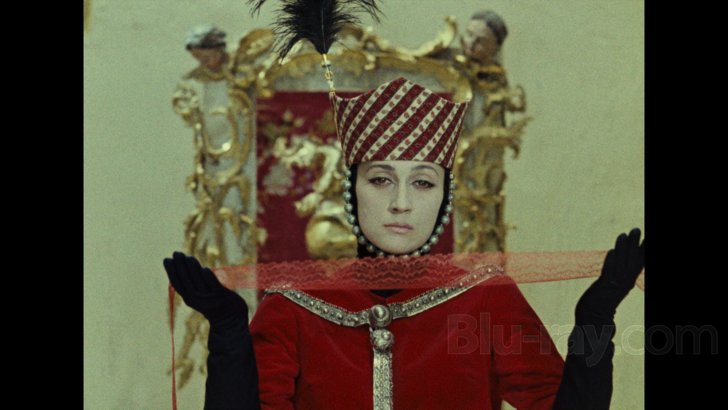
Presented in its original aspect ratio of 1.37:1, encoded with MPEG-4 AVC and granted a 1080p transfer, Sergei Parajanov's The Color of Pomegranates arrives on Blu-ray courtesy of Criterion.
The following text appears inside the leaflet that is provided with this Blu-ray release:
"The Color of Pomegranates was restored by Cineteca di Bologna/L'Immagine Ritrovata and The Film Foundation's World Cinema Project, in association with the National Cinema Centre of Armenia and Gosfilmofond of Russia. This new digital transfer was created in 4K resolution from the 35mm original camera negative, provided by Gosfilmofond in Russia, and a 35mm duplicate negative from the National Cinema Centre of Armenia. The scan was created at Gosfilmofond, and the restoration was performed by L'Immagine Ritrovata in Bologna, Italy. A 35mm Armenian reference print was used to help reconstruct this cut of the film, the closest to Sergei Parajanov's intended version, and a 35mm print held by the Harvard Film Archive was used as a color reference. The restoration was funded by the Material World Charitable Foundation. The monaural soundtrack was remastered from the original 35mm magnetic soundtrack preserved by Gosfilmofond, in addition to the Armenian reference print.
Transfer supervisor: Cineteca di Bologna and L'Immagine Ritrovata, Italy."
I cannot say that I am impressed with the 4K restoration. I have this DVD release of the film from British label Second Sight in my collection which features a different edit of the film, and while I am not satisfied with the color grading there either, I actually think that there are some color values that are closer to what should have ended up on the restoration. Of course the DVD release comes with all sorts of other issues, some directly related to the inferior nature of the format, so in the grand scheme of things it is utterly pointless to use as a reliable reference source. On the Blu-ray transfer delineation, fluidity, and depth are vastly superior, and there are literally portions of footage that reveal nuances that are lost on the DVD release. However, despite the fact that a reference print was used to color grade the new transfer, I can recognize some very specific issues that are typical for restorations that come out of L'Immagine Ritrovata. (Specific LUT settings, for instance, destabilize the native dynamic range of the film, though this is one of the better-balanced recent jobs that I have seen). Overall image stability and transitions are excellent. Also, the entire film has been carefully cleaned up and now looks spotless. My score is 3.75/5.00. (Note: This is a Region-A 'locked" Blu-ray release. Therefore, you must have a native Region-A or Region-Free player in order to access its content).
*Screencaptures #21-25 are taken from the DVD release that is referenced above.
The Color of Pomegranates Blu-ray Movie, Audio Quality 
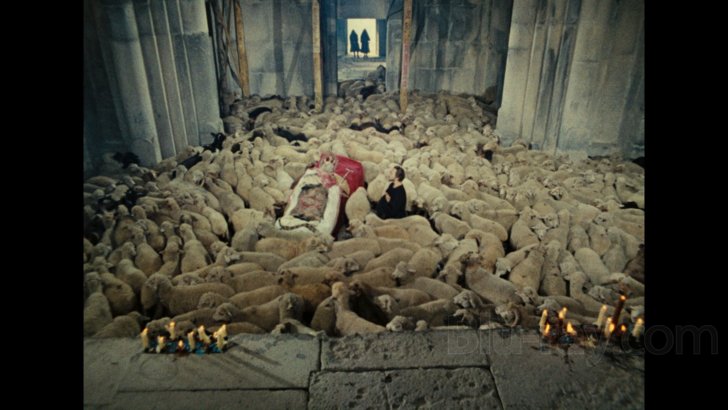
There is only one standard audio track on this Blu-ray release: Armenian LPCM 1.0 (with portions of Georgian and Azerbaijani). Optional English subtitles are provided for the main feature.
The native qualities of the original soundtrack offer a limited range of dynamic contrasts and nuances, but clarity is excellent. Also, stability is very good. On the old DVD release that I have from time to time it is quite easy to detect minor pops, but such are not present here. (Obviously, here the audio is also properly pitched).
The Color of Pomegranates Blu-ray Movie, Special Features and Extras 

- The Color of Armenian Land (1969) - this vintage documentary directed by Mikhail Vartanov features raw footage from the making of The Color of Pomegranates. Music only. (17 min, 1080p).
- Redefining Cinema - in this new video interview, film scholar James Steffen (The Cinema of Sergei Parajanov), discusses the cinematic style of Sergei Parajanov and The Color of Pomegranates. The interview was conducted exclusively for Criterion in 2017. In English, not subtitled. (18 min, 1080p).
- Decoding The Color of Pomegranates - in this video essay, James Steffen takes a closer look at some of the symbolism that defines The Color of Pomegranates. The program was created exclusively for Criterion in 2017. In English, not subtitled. (43 min, 1080p).
- Sergei Parajanov: The Rebel (2003) - this vintage documentary examines examines the life, legacy and artistic personality of Sergei Parajanov. Included in it are clips from archival interviews with the director, film historian Jean Radvanyi, actress Sofiko Chiaureli, and others. The documentary was produced by Patrick Cazals. In Armenian, Russian, and French, with optional English subtitles. (52 min, 1080i).
- The Last Film (2015) - this experimental short documentary by Martiros M. Vartanov, founder of the Parajanov-Vartanov Institute, pays tribute to filmmakers Sergei Parajanov and Michail Vartanov. In Armenian and Russian, with printed English subtitles. (4 min, 1080p).
- Commentary - in this new audio commentary, critic and filmmaker Tony Rayns deconstructs The Color of Pomegranates and discusses the life and legacy of its creator, Sergei Parajanov. (There are some excellent stories about the director's colorful personality as well). The commentary was recorded exclusively for Criterion in 2017.
- Leaflet - an illustrated leaflet featuring critic Ian Christie's essay "Parajanov Unbound" and technical credits.
The Color of Pomegranates Blu-ray Movie, Overall Score and Recommendation 
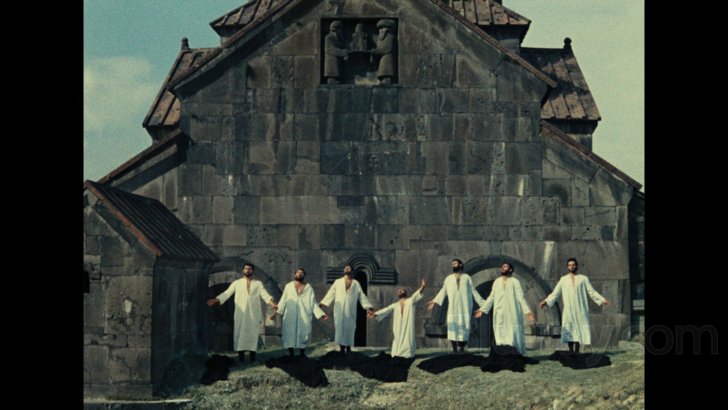
My experience with The Color of Pomegranates began many years ago during a studio screening which left me as puzzled as I have ever been after viewing a film. I did quite a bit of research after that so that I could find the right way to appreciate and enjoy it, but I never arrived to the conclusion that it is the timeless masterpiece that a lot of critics have argued it is. I think that it is a very strange film, rebellious in a way that makes it awfully difficult to rationalize, and beautiful but also promoting a style that is quite unforgiving. Naturally, like all difficult films I think that it absolutely should be seen and talked about. However, I urge you to take with a grain of salt the many glowing articles about the film that have been published in the past and especially the ones that 'explain' its brilliance. If you do so and then approach the film, there is an excellent chance that you will have a far more satisfying experience with it. Criterion's release is sourced from a recent 4K restoration of the film that I find rather frustrating, but currently it is the best presentation on the market. RECOMMENDED, but proceed with caution.
Similar titles
Similar titles you might also like

Andrei Rublev
Андрей Рублёв | Andrey Rublev | Tarkovsky's Preferred Cut and Original versions
1966

Mirror
Зеркало / Zerkalo
1975

The Dance of Reality
La danza de la realidad
2013

Satantango
Sátántangó
1994

The Passion of Joan of Arc
La passion de Jeanne d'Arc / 24 and 20 frames per second versions
1928

Fellini's Casanova
Il Casanova di Federico Fellini
1976

Napoléon
Napoléon vu par Abel Gance
1927

Endless Poetry
Poesía sin fin
2016

Ludwig
1973

Danton
1983

Sebastiane
Derek Jarman
1976

Confucius
孔子 / Kong zi
2010

The Flowers of St. Francis
Francesco, giullare di Dio
1950

Cemetery of Splendor
2015

City of Life and Death
南京!南京! / Nanjing! Nanjing!
2009

Mishima: A Life in Four Chapters 4K
Director's Cut
1985

Farinelli
1994

La Vie en Rose
La Môme / Warner Archive Collection
2007

Gainsbourg: A Heroic Life
Gainsbourg: Vie héroïque
2010

Hard to Be a God
Трудно быть Богом
2013
